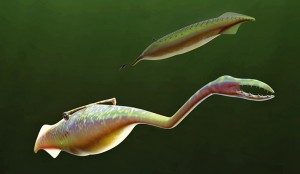The Riddle of the Tully Monster
March 25, 2016

A reconstruction of the Tully Monster as it would have looked 300 million years ago, swimming in Carboniferous waters. Notice the jointed snout, the multiple rows of teeth, and the eye bar on the animal’s back. Credit: © Sean McMahon, Yale University
Over 300 million years ago, a strange creature lived in the rivers of Illinois. This creature was so bizarre that, after its fossil remains were discovered, it left paleontologists baffled for more than 60 years. Now, a group of scientists led by Victoria E. McCoy from Yale University seems to have finally discovered the true nature of the so-called Tully monster. The findings were published in the journal Nature on March 16.
Fossils are the marks or remains of organisms that lived thousands or millions of years ago. Some of the best-known fossils include leaves, shells, or skeletons that were preserved after a plant or animal died. The Mazon Creek region in north-central Illinois is one of the most important fossil sites in the world. It gives paleontologists a window into life over 300 million years ago, long before the dinosaurs ever existed. At this time, called the Carboniferous Period, the Mazon Creek area was a tropical river delta. (Because of the movement of the tectonic plates, Illinois was at that time near the equator and the ocean reached as far as Illinois.) Occasionally, floods would wash land- and river-dwelling organisms from the Mazon Creek area into the ocean and bury them—along with some ocean animals—under a thick layer of sediment. Compounds from the decomposing organisms changed the chemical makeup of the sediment around them. Over time, this sediment hardened to form a protective rock called a concretion around each organism.
In the 1800’s, people were mining for coal in the area and found these concretions. When cracked open, the concretions often revealed animals and plants preserved in exquisite detail. Amateur, as well as professional fossil hunters have scoured the area ever since. One amateur, Francis Tully (1912-1987), discovered a strange creature in 1955. When he turned it over to scientists at Chicago’s Field Museum, they named it Tullymonstrum gregarium—the common Tully monster—in his honor.
To the untrained eye, a Tully monster fossil might just look like a leaf. The animal had a long, oval-shaped body with two triangular tail fins. Its eyes rested on a skinny rod or bar. On top of all that, it had a long, wormlike snout ending in tiny, toothed jaws. From snout to tail, the whole creature grew little more than a foot (30 centimeters) long.
Paleontologists knew the Tully monster was an animal, but its strange body plan had long frustrated attempts to figure out which group of animals it belonged to. Over the years since it was discovered, different scientists have suggested it was related to squid, clams, snails, slugs, and many different kinds of worms. None of these guesses gained much traction.
This new team of scientists, however, noticed something that the others had overlooked. They realized that the thin, light band running along the length of the Tully monster, previously thought to be a digestive tract, was in fact a notochord. A notochord is a rodlike, flexible cord that runs down the back of the body in many early vertebrates. That meant the creature was more closely related to fish than it was to squid and worms. From there, the other pieces fell into place. The shape of the notochord and the structure of the gills and teeth indicated that the Tully monster was related to modern lampreys. Finally, the Tully monster, the state fossil of Illinois, has its place on the Tree of Life.
Other links and articles


